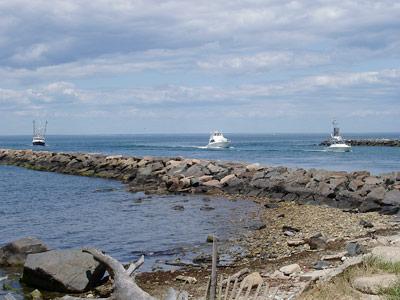Town Board Okays ‘Deluxe’ Montauk Inlet Plan

The Town of East Hampton is set to give its approval to a $41 million Army Corps of Engineers plan that calls for dredging and enlarging the navigational channel into Montauk Harbor — to ensure safe access for the commercial fishing fleet, which has been coping with increasingly difficult passage — and to deposit sand on beaches along Block Island Sound to the west, create a new public beach there, and install three groins perpendicular to the shore.
With federal money covering 70 percent of the cost, and state money thrown in, the town’s share was estimated previously at $1.5 million, though a new estimate has not been calculated. The plan is the most ambitious of three options presented by the Corps, which is completing a feasibility study for the future of the inlet. Work is not likely to begin until 2015, Brian Frank, an environmental analyst for the town, said at an East Hampton Town Board meeting on Tuesday, after a new Congressional delegation allocates funding.
Although the plan would provide some shoreline stabilization to address chronic erosion along Soundview Drive, it requires the town to obtain deeded access over private property to the beach, or to condemn land if necessary. These costs would be borne solely by the town.
There are also questions, town board members noted, during Tuesday’s work session, regarding the ultimate effect of the groins, responsibility for maintaining the beach, and the town’s liability should private properties be negatively affected after the Army Corps finishes the project and hands off responsibility.
The board unanimously agreed to approve the “deluxe package,” as Town Supervisor Bill Wilkinson dubbed it, provided the Army Corps allows for the ability to scale back the project should any of the requirements or components become problematic. Mr. Frank said the federal agency had indicated that it would agree to that concept, though town officials said they would seek written confirmation.
Armoring the shoreline in the area is permitted under the town’s Local Waterfront Revitalization Project, but not hard structures perpendicular to the shore, such as the proposed groins. Mr. Frank said the three groins would initially be made of geotextile tubes and left in place for a trial period of 10 years so that their effect on downdrift could be observed. The groins’ size, height, orientation, and so on could be adapted before being permanently constructed out of stone or steel.
The construction of the groins would require the town to obtain access to the beach from private property owners, a number of whom objected to the idea during a public comment period last year. They expressed concern about property values as well as the creation of a public beach, one of the federal requirements when a project includes beach reconstruction. Whether the reconstructed beach would be eligible for rebuilding by the Federal Emergency Management Agency after future storms, or whether the town would have to bear the cost, remains a question.
Last year, Supervisor Wilkinson said that, in choosing the most ambitious Army Corps plan, the town “would be held up a long, long time, for a bunch of reasons.” The Planning and Natural Resources Departments, Mr. Frank reported then, recommended choosing a lesser plan, citing “too many unanswered questions” associated with the dredging and beach restoration. But, he said, “If there were a viable option for restoring a sandy beach west of the inlet, that’s obviously in everybody’s best interest — for the property owners, for the public, for the environment.”
Under a less ambitious “enhanced navigation” option, to which the town would revert should the larger effort fail, the inlet would be deepened to 17 feet below sea level and the basin widened to 100 feet. A new area of dredging at the southeast end of the inlet would be included, and the spoil would be deposited on the West Lake Drive beach to the west, which is closer to the inlet than the Soundview properties. Of a total projected cost of $26 million for that work, the town would be expected to pay $801,000.
Another possibility, to maintain existing conditions at the Montauk inlet by periodic dredging to a depth of 12 feet, would be fully covered by federal funds, but it has been considered insufficient.
The Army Corps, which recently completed its Fire Island to Montauk Point reformulation study, has imposed a Sept. 20 deadline for the town’s decision. Any action contemplated by the town is complicated by an ongoing lawsuit by some property owners along Soundview Drive and Captain Kidd’s Path against the town, New York State, and the Army Corps over the impact on their eroding shores of existing groins that mark the channel.
Frank DeVito, a Captain Kidd’s Path homeowner who is one of the lawsuit plaintiffs, told the town board on Tuesday that the plaintiffs would like to reach a settlement with the town and to see long-term solutions for the shore. “It’s not your fault, or the board’s,” he told Mr. Wilkinson, who bristled at the suggestion that he had not been responsive to the waterfront homeowners and pointed out that he had personally helped Mr. DeVito get rocks installed when his house was in peril. “But we’re pleading for help,” Mr. DeVito said. “It’s been 15 years, and we’re still pleading for help.”
Larry Wagenberg, the vice president of the Culloden Shores Association, which is not a party to the lawsuit, also appealed to the board on Tuesday to address the “major erosion issue.”
“I just know that something has to be done. And if we let a lawsuit get in the way of all these families . . . it’s not a very pragmatic position.”
